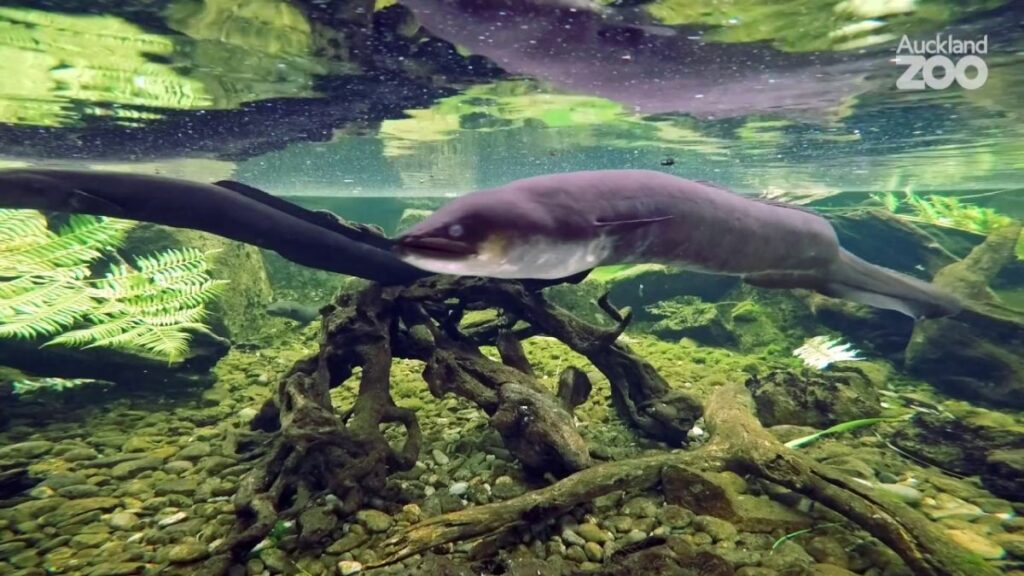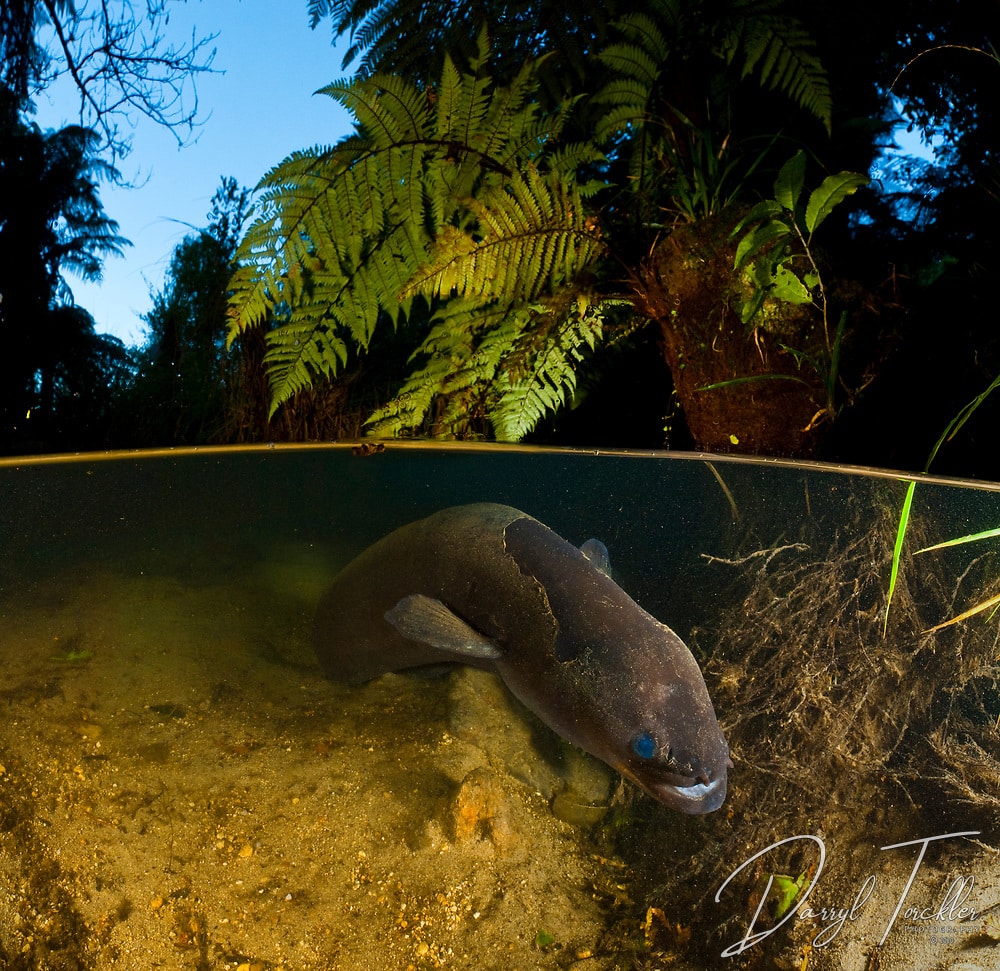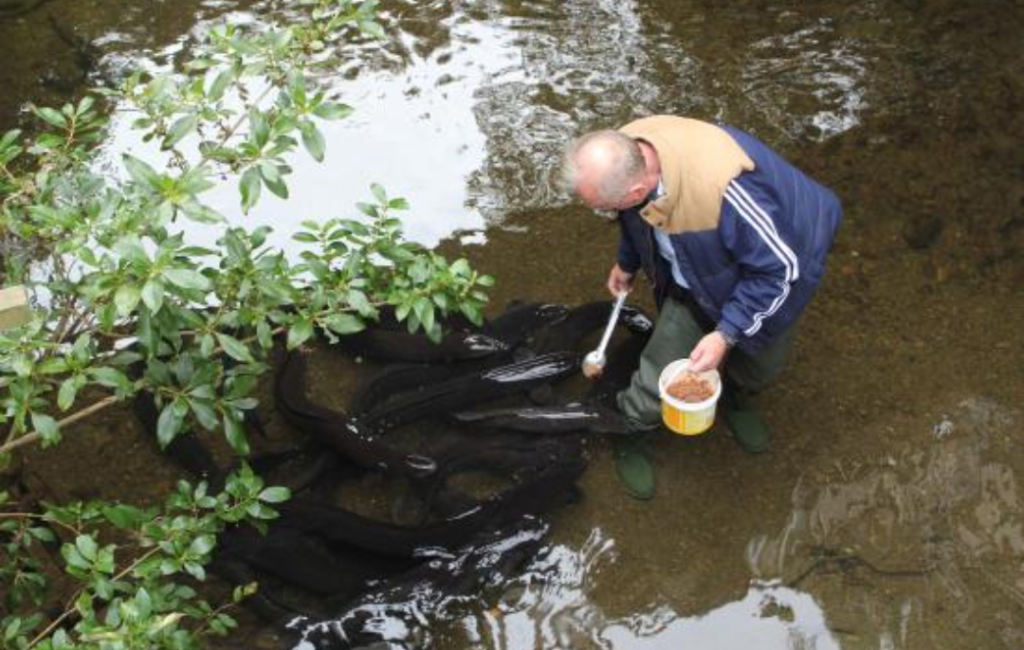The New Zealand longfin eel is the only eel endemic to New Zealand and is also the world’s largest eel. These eels get their name from their exceptionally long dorsal fin. The shortfin eel and spotted eel also live in New Zealand but are not endemic.

Like sea turtles, environmental conditions determine the sex of a longfin eel. New Zealand’s longfin eels spawn and die in the ocean, but they live most of their lives in freshwater. They choose rivers, lakes, or wetlands with lots of hiding places.
Longfin eels are also long-lived, with some females living upwards of 100 years.
They are carnivorous hunters and scavengers. They eat anything they can fit in their mouths. As adults, they mostly eat fish and invertebrates.
One remarkable characteristic of the longfin eel is its ability to climb. Like salmon, eels must travel upstream to reach their ideal habitat. The river often has obstacles, like dams and waterfalls. Their solution is to literally climb over the obstacles. Sometimes, land separates bodies of water. So, the eels slither across the land to reach their destination.
The reproductive habits of eels are not well understood, but they are fascinating. As they mature, adult eels travel back to the ocean to spawn and die. They often travel for thousands of miles/kilometers without rest.
After hatching, eel larvae make the opposite journey. The tiny, transparent eels travel thousands of miles/kilometers to freshwater. After their larval stage, they become juvenile glass eels. Then, they become juvenile elvers before finally becoming adult silver eels.
New Zealand researchers tried to track the migratory patterns of these eels. Unfortunately, they haven’t had much success. Despite this, they continue to pursue their research.
These eels face many threats, the worst of which is overfishing. Their populations are declining and face many threats. Yet, researchers are hopeful for the future.
Longfin eels have been culturally significant to the native Maori for years. Then, the European settlers who came to New Zealand hated the eels and sought to eradicate them. Fear of the eels still lives on, but they are gaining more respect and understanding. Today, there is more hope for longfin eels.
Plus, if you’ve ever wondered how to x-ray an eel, we’ll show you how it’s done. The Auckland zoo in New Zealand was the first to accomplish the feat.
What Is The New Zealand Longfin Eel?
The New Zealand longfin eel is the only freshwater eel native to the country. They have been swimming from the ocean to New Zealand’s waterways for millions of years. Research shows they’ve been around since at least the early Miocene era, 23 million years ago.
Appearance
Their bodies are dark brown to black. They have exceptionally long dorsal fins longer than their ventral fin. Their bodies are long and slender, like a tube. As juveniles, their heads are small and smooth. As they grow, their heads become bulbous, with a large dome of muscles sitting behind the eyes.
It doesn’t look like it, but eels have scales, like every other kind of fish. Their skin is thick and leathery, and the scales are embedded into the skin. Their skin is extra sensitive to the touch. They use feeling to navigate their dark, watery environment.
New Zealand’s longfin eels are also one of the largest species of eels in the world. Females grow much larger than males, with the longest-lived females reaching up to 5 ft (1.5 m). Despite growing to such large sizes, they grow slowly, only about 0.39-2 in (1-5 cm) a year.
The heaviest longfin eel ever caught by a fisherman was an astounding 88.2 lbs (40 kg). Today, it’s not nearly as common to see longfin eels that get so large. Due to overfishing and other threats, it’s rare to find an eel of more than 22 lbs (10 kg).
Lifespan
Longfin eels are exceptionally long-lived. The oldest females were almost 100 years old. The average lifespan of a female New Zealand longfin eel is 20 to 60 years. Males have significantly shorter lives of just 12-25 years.
Becoming Male Or Female
The sex of a longfin eel doesn’t come from genetics but from the surrounding conditions. You’ve likely heard that temperature determines a sea turtle’s sex. The process is similar for eels, but the temperature doesn’t determine their sex. Instead, their sex is determined by the number of eels in a particular population.
Adults can sense how many eels live nearby in their population. They will produce more female offspring if the established population is primarily male. Likewise, they’ll produce more males if the population is primarily female.
- Common Names: New Zealand longfin eel
- Electric Eel Scientific Name: Anguilla dieffenbachii
- Origin: New Zealand
- Length: Up to 5 ft (1.5 m)
- Average Lifespan: 12-25 years (males) & 20-60 years (females)
Habitat

These New Zealand eels are endemic to New Zealand’s north and south islands. They are not picky about the water they inhabit, even living at high elevations. Most eels choose to live in rivers, but they also inhabit lakes and wetlands. They spend most of their time hiding. They find concealed spots within thick vegetation or under a bank.
Behavior & Temperament
A considerable part of their life consists of migrating to and from freshwater. Doing so forces them to go up and down rivers where they face obstacles, but they don’t let that deter them. The rivers of New Zealand often have hydropower dams built across them. The dams cause problems for eels and salmon alike.
The Amazing Climbing Eels
You’ve likely seen videos of salmon leaping over dams to make their way upstream. Their jumping ability is an impressive feat by itself. Still, New Zealand’s longfin eels have found an even more incredible way to cross the dams: climbing.
Unlike most fish, eels can survive outside of water for a significant amount of time. All they need is to remain damp and cool. They use their ability to leave the water to cross over dams and waterfalls. They have been known to climb over obstacles up to 65.6 ft (20 m) in height.
As longfin eels reach a dam, they climb vertically over its surface until they reach the rest of the river. Many of New Zealand’s hydropower facilities have made accommodations for the eels. Many dams have small ladders attached to the dams specifically for the eels to climb. The construction of the ladders allows a small trickle of water to run down the ladders. The water helps keep the fish damp and cool.
Slithering Over Land
These eels don’t just leave the water to traverse dams and waterfalls; they also use it to migrate over land. Sometimes, the watery habitat they seek is separated by land. So, they have no choice but to slither across the ground to get where they need to go. They can breathe through their skin, allowing them to stay out of water for up to two days.
Diet
New Zealand longfin eels are not particular about their food. They will munch on almost anything they can fit in their mouths. They are carnivores known for eating fish, invertebrates, rodents, and even ducklings. Juveniles eat similar, but smaller, items like worms, aquatic snails, and insect larvae.
Longfin eels are excellent hunters who use their keen sense of smell to seek prey at night. Their nostrils protrude from their face, which helps them smell better. They also have giant mouths with several rows of tiny, sharp teeth.
Freshwater Eels Migrate To Spawn
Until recently, we had no idea how eels reproduced; we could never observe the process.
After tiring research, scientists finally managed to track eels to their spawning grounds. Unfortunately, the eels they tracked were not New Zealand longfin eels, but American eels.
All Eels Spawn In The Ocean
Freshwater eels evolved from fully marine eels. So, freshwater eels spend most of their lives in freshwater but return to the ocean to spawn. The Maori people refer to this migration as “heke.”
Researchers now know that eels native to America and Europe migrate to the Sargasso Sea to spawn. Freshwater eels native to Asia travel to the North Pacific to spawn.
Researchers are still unable to track the larvae of New Zealand longfin eels. So, their exact spawning grounds are still unknown. Still, this wasn’t for lack of trying.
Tracking The New Zealand Longfin Eel
Don Jellyman works at New Zealand’s National Institute of Water and Atmospheric Research. He is an emeritus fisheries scientist who has been studying eels for decades.
Jellyman and his team were the first to attempt tracking New Zealand longfin eel larvae. They conducted their research between 2002 and 2010. Their goal was to track migrating adult longfin eels. They wanted to see them travel from freshwater to their saltwater spawning grounds. Unfortunately, the team didn’t have much success.
The researchers placed tags on the eels for tracking, but the tags needed light to operate. Without sunlight, the tags couldn’t accurately calculate longitude and latitude.
The eels didn’t want to swim in the shallow waters where the tags could operate, though. Instead, they dove deep where the light could no longer penetrate the water. One eel from the operation dove to an incredible depth of 3,200 ft (980 m).
Without enough sunlight, the tags only reported the eels’ locations at pre-set times.
Spawning Grounds Between New Caledonia & The Tonga Trench
The furthest location the tags reported placed an eel 2,296.6 ft (700 m) east of New Caledonia. That information places their spawning grounds between New Caledonia and the Tonga Trench.
We still don’t know the exact migration route of these eels. Still, the tags prove they migrate to tropical waters when it’s time to spawn. The tags also show that the journey takes about five to six months — an impressive feat. In total, these eels migrate approximately 3,106.9 ft (5,000 km) to their spawning grounds.
Continued Research
The first tagging program wasn’t very successful, but Jellyman and his team plan to try again. Hopefully, in the next few years, we will have a definite answer to where New Zealand’s longfin eels spawn.
The Lifecycle Of Eels

Researchers know more about the spawning process than they do about the migratory process. Eels have a total of six life stages.
Eggs
A single female eel releases millions of eggs at the spawning location into the water column. Spawning is a mass event, so hundreds of eels arrive at the spawning area and release their eggs at once. Once the eggs are in the water, the males release their sperm to fertilize the eggs.
Leptocephallii
Once the eggs hatch, they produce leaf-shaped transparent larvae called “leptocephallii.” Upon hatching, these larval eels are a mere 1 mm in length.
These leptocephallii spend about seven to ten months free-floating through the ocean. They slowly make their way to their permanent freshwater homes. As they drift, they feed on microscopic zooplankton in the water.
Glass Eels
The leptocephallii continue drifting for several months. Then, they reach the coast of New Zealand between August and October. Once they reach the coast, they transform into glass eels. Their bodies slowly adapt to freshwater as the salinity drops. Many glass eels travel together in groups called “shoals.” Shoals may consist of hundreds of glass eels. They can travel for several days without stopping.
Glass eels are susceptible to predation, so they stay at the bottom of the river, where it is safer. They remain here until summertime — between January and February in New Zealand.
As summer hits, the glass eels begin making their way upstream. Researchers believe that glass eels choose their path upstream by smelling. They follow the scent of more mature eels already living upstream.
Elvers
Once the glass eels reach freshwater, they metamorphize again. Glass eels transition into juvenile eels called “elvers.” Elvers are no longer transparent but take on the dark coloration of adult eels.
Although they look like adults, elvers are juveniles. Elvers continue traveling through the river until they find a spot that suits them.
Yellow Eels
After the elver stage, eels transform one last time into “yellow eels.” Yellow eels remain in this stage for several years — the majority of their lives. They look identical to adult eels, but they are not sexually mature. Once they choose a place to call home, they remain there until they reach sexual maturity.
Silver Eels
An adult eel, or silver eel, retains the same dark color as the elvers, although it may shift slightly. Their eyes become large, sometimes twice the size of what they are normally. The size increase is helpful because they migrate day and night, so their large eyes help them to see. Their bodies become thinner and sleeker. The change helps them adapt to their new saltwater conditions. Their heads also become slimmer and tapered, almost bullet-shaped.
A longfin eel becomes a silver eel because of physiological and environmental cues. Researchers aren’t entirely sure what causes elvers to transition to adults. Yet, once they do, the eels are ready to migrate back to the sea. Despite living for an average of 12-60 years, most of an eel’s life is spent as a juvenile.
The eel’s health and energy stores likely determine the transition. The long migration back to the sea requires incredible strength and energy. So, only the healthiest eels survive the journey.
A silver eel’s sole purpose is to breed, and they only do so once. Once they reach sexual maturity, they spawn — an act that leads to their immediate death.
Conservation
New Zealand longfin eels are a key species in river habitats. They are scavengers that help the health of the water.
Population Status
Previously, the New Zealand government listed longfin eels as “not threatened.” They received this status despite their populations still declining. Today, the government lists them as “At Risk — Declining” — a status they’ve held since 2014.
The International Union for the Conservation of Nature (IUCN) also assessed their populations. The IUCN Red List marks these New Zealand eels as “endangered,” a status they’ve held since 2018.
They face the dangers of habitat loss, water pollution, and hydropower dams. They are also at risk from recreational and commercial fishing.
Hydropower Dams
Many hydropower dams work to accommodate the eels with their climbing ladders. Yet, they’re rarely enough. It’s easier for the smaller, juvenile eels to get up and over the dams. It’s not as easy for larger silver eels to get back down the dams. Plus, if the eels enter a turbine, they will die.
Another issue is the pumping stations located throughout lowland water habitats. The pumps prevent flooding, but they can also suck up the eels. Eels that get sucked into a pump do not survive.
Commercial Fishing
Despite declining populations, commercial fishing for the longfin eels continues. There has been pushback from the Maori people and conservationists. As a result, there is a quota for how many eels a fishery can catch. The quota has been reduced in the last few years.
Pollution
Pollution of New Zealand’s freshwater waterways also harms the eel populations. Pollution occurs from sewage and runoff from meat production plants and paper plants. The pollution reduces the oxygen content in the water, making it inhabitable for the eels. As a result, the eels die or must move habitats.
The Nature Conservancy’s New Zealand Program
The Nature Conservancy has begun working on the “New Zealand project.” They are working to reduce freshwater pollution. In particular, they are working in the Waikato landscape. Waikato is one of the most intensely farmed areas of the North Island. The Nature Conservancy wishes to make its freshwater rivers healthier. Healthier waters will boost the health and populations of eels and other fish.
Cultural Significance

The people of New Zealand have had a love-hate relationship with eels for hundreds of years. Longfin eels were important to the culture of the Maori people. Conversely, the European settlers hated them. Today, many locals and tourists are still scared of eels. Still, inhabitants are becoming more receptive to eels. They are beginning to understand their cultural and ecological importance.
The Maori People
New Zealand’s longfin eels were always a large part of Maori culture. The Maori call eels “tuna,” and they are considered a “taonga,” or “cultural treasure.”
Long ago, the rivers of New Zealand were full of these eels, and they were easy to catch. Their meat is highly nutritious, so they made an excellent food source for the Maori. They didn’t have to worry about the meat going bad, either. They could transport the eels while they were still alive.
Due to their vast importance, much traditional Maori art comprises depictions of eels. They also made their way into their folklore.
European Settlers
Then, European settlers began inhabiting New Zealand. They made their distaste for the eels well-known. They introduced their favored fish to the rivers, like brown and rainbow trout. They made it their mission to kill the eels because they were predators of their beloved trout. They offered bounties for each eel killed that lasted into the 1950s and 60s.
Europeans were not interested in eels for their fisheries until the 1960s. It was at this time that their commercial catches began to rise steadily. By 1975, eels were the second most valuable fish export for New Zealand. They were only outmatched by rock lobster exportation. The success of the fishing industry led to population decline. The average size of the eels they were catching also declined.
Modern Respect For Eels
More recently, the locals have garnered a newfound respect for their longfin eels. Their respect stems from better research. They can see how eels play a key role in the ecosystem and benefit fishermen. Rivers without eels have more trout. Still, the fish are smaller because they must compete with each other for food.
Children & Eels
Eels are common in rural New Zealand waters, so those who grow up there are used to encountering them. Many children and fishermen lure them out of hiding with some food. Often, locals use some eggs as a lure, but even chips work wonders.
The children of New Zealand fish for eels, eat them, and even keep them as pets. It’s rare, but sometimes the eels will bite swimmers, but children are clever and found a way to avoid this. Before swimming in a river or lake, children jump in like a “bomb” to create a large splash and scare the eels away.
One of the most popular children’s books is Watercress Tuna and the Children of Champion Street. The book is about a magical eel that helps a diverse New Zealand community come together.
Keeping Eels As Pets
Many New Zealanders keep longfin eels as pets and grow attachments to them. The Whangarei family kept one eel as a pet for 35 years. The eel, Eel McPherson, lived in a large pool. Unfortunately, the eel was swept away during heavy floods. Its caretakers mourned their loss for a long time. They stated that it would be easy to get a new eel, but it wouldn’t be the same.
Eel Tourism
Interestingly, New Zealanders have made eels a tourist attraction. The goal is to garner support for eels and reduce fear. The Jester House Cafe outside Motueka gives you a chance to feed “tame” eels in the stream outside their cafe. The cafe offers a stick and a bit of food for a few dollars. As you head down to the stream, you’ll see a large, wiggly mass of eels awaiting their anticipated meal.
The Wop Wop Wetlands eco-park and the National Kiwi Centre in Hokitika offer similar experiences.
Other New Zealand Eels
No other eels are endemic to New Zealand, but some other species call the country home.
The shortfin eel (Anguilla australis) lives across New Zealand. They also live in Australia and the surrounding Pacific Islands. Shortfin eels are lighter than the New Zealand longfin eels. Their bodies are light brown to olive, and their dorsal fins are shorter. Shortfin eels more commonly live in lowland areas like wetlands and marshes.
The spotted longfin eel (Anguilla reinhardtii) is not a permanent resident. Instead, they occasionally visit from Australia. These eels have dark brown or olive blotches on their backs and the sides of their body. The pectoral fins are often a lighter yellow.
How Do You X-Ray A New Zealand Longfin Eel?
The Auckland Zoo houses New Zealand longfin eels. They need medical care just like the rest of the zoo’s inhabitants. At one time, the zoo housed eleven longfin eels. Their keepers noticed that one of the eels had a slight bend to its back. So, they recommended the veterinary staff take a look.
The team had never x-rayed an eel before and knew it would be difficult. The animals are wriggly and slimy, so keeping them still is hard. Records show that the Auckland Zoo veterinary staff may be the first to x-ray a long-finned eel. Still, they utilized the standard method in x-raying fish like sharks.
The staff set up a medical tank with anesthetic and warm water. The anesthetic comprises mainly clove oil which gently puts the eel to sleep. Eels can stay out of the water for some time, so the procedure was not difficult once the eel was asleep. They kept the eel’s head covered to keep it dark and proceeded with the x-rays as usual.
After the x-rays were over, the team placed the eel back into the medical tank for an ultrasound. They were able to do the ultrasound right in the water to make the procedure easier on the fish. The eel was slimy and difficult to hold onto. One zoo staff member said, “It’s like ultrasound scanning a bar of soap.”
Upon viewing the x-ray, the veterinarian could see the eel had an abnormal spine curvature. He also noticed a collapse in the space between the vertebrae where the eel had a lesion.
The findings showed that there was no sign of fracture or trauma. Instead, vet staff thinks a vitamin C deficiency likely caused the curvature. The team planned to review how they distributed nutrients to their eel inhabitants.
FAQs
As far as we can tell, there is nothing stating that you can’t keep a New Zealand longfin eel as a pet. People in New Zealand keep them as pets frequently, so it is legal for locals. Recreational fishers can take up to six longfin eels per person per day. Whether you can travel to New Zealand and take an eel home is unclear but unlikely.
Interestingly, New Zealand longfin eels have toxic blood. The blood can be fatal if ingested by a small animal. Many New Zealanders enjoy eating longfin eel meat. It is completely safe after cooking. Still, take caution when fishing or interacting with a longfin eel, especially if it has a cut. Eel blood that gets into your eyes, nose, or a cut will cause painful swelling that lasts for days.
New Zealand’s longfin eels are said to be dangerous, particularly if you have a cut. In truth, this sentiment is largely a myth. They can smell the blood and routinely attack things larger than themselves. Still, while bites are somewhat common, full-out attacks on humans are incredibly rare. Humans are far more dangerous to longfin eels than they are to us.
